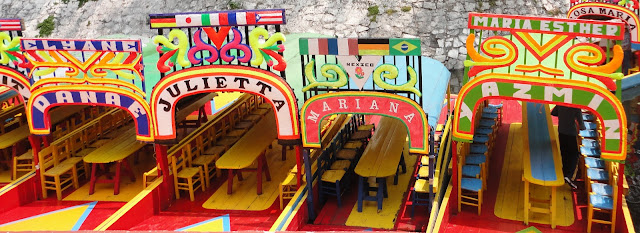We began with a stop in Coyoacan, which has mcuh more of a 'neighborhood' or even a small town feel than much of the rest of the city. Over the years, it has been very much of an artists' colony -- a bit more relaxed, open, and 'bohemian.' This is the central plaza and the colonial church of St. John Baptist.

The interior of the church is richly decorated, although it did not seem as 'over the top' as some of the other colonial era churches I have seen.
The painted ceiling with gilt trim was particularly beautiful.
It's a colorful neighborhod in many ways:
One of the street vendors had a trained bird that picked out your 'fortune' from a stack of cards. It was actually a bit creepy...
We then visited Casa Azul, "The Blue House," the home where Mexican artist Frida Kahlo was born and grew up. Eventually she also died there, after a life that seems to have been tumultuous. She was married to Diego Rivera, another Mexican artist (and divorced from him and remarried to him -- twice, I think). She was in constant and severe pain due to injuries from a car accident; she was a communist; she was one of the great champions of indigenous Mexican art and culture. Many of her works are on display in the house, along with several rooms of her furniture and her studio. The house appeared to be a series of interconnected buildings surrounding a lovely courtyard garden.
From Frida's collection of indigenous and folk art that was on display:
We stopped briefly at the National University -- which boasts something like 120,000 students. The most famous landmark at the University (locally called UNAM -- Universidad Nacional Autonomo de Mexico) is the library. The facade appears to be covered by a brightly painted mural -- it's not, it is a mosaic, designed by the Mexican artist Juan O'Gorman.
The mosaic depicts not only the history of Mexico, but also traces the Western cultural heritage of faith and reason.
The highlight of the day was the trip to Xochimilco. It's hard to imagine from the appearance of modern day Mexico City, but for many hundreds of years, the Aztec capital was actually situated in a lake. Not on or near a lake, but it was an island surrounded by an elaborate grid of canals. The Spaniards got the bright idea to drain the lakebed to build their capital of New Spain, which is why nowadays the historic center of the city is sinking, and many of the buildings downtown are leaning to one side or another. Xochimilco is what remains of that watery city -- it is a place for recreation and relaxation.
Colorfully decorated boats known is trajineras ply the waters. They are named after women, and the drivers use long poles to reach down into the lake bottom to push the boats along.
As you can see above, down the center of the long, narrow boat there is a table, with seats on two sides. This is perfect for putting drinks or food, and as we floated along the canal other boats came alongside us selling soft drinks, beer, and food. This picture gives something of an idea of the traffic on the canal:
Other boats had musicians, including both marimba and mariachi bands. For a small fee, they were happy to play and sing for our entertainment.
All in all...a great day!

















No comments:
Post a Comment